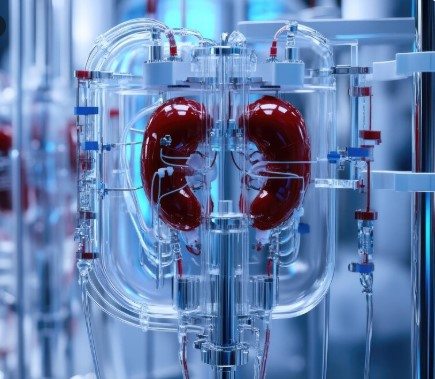New microfluidic device brings affordable kidney testing to the point of care

Chronic kidney disease (CKD) affects over 800 million people globally and is often diagnosed too late for effective intervention. Early detection depends on accurate measurement of biomarkers such as creatinine and the urine albumin-to-creatinine ratio (uACR). While urine testing is non-invasive and informative, standard methods are time-consuming, costly, and require specialized facilities. Existing point-of-care devices offer convenience but remain prohibitively expensive or technically complex for many users. As such, there is an urgent need for a robust, affordable, and easy-to-use platform to measure urinary creatinine with clinical precision. Due to these challenges, new approaches are needed to develop accessible diagnostic tools for CKD screening and monitoring.
Researchers at the University of Manitoba, in collaboration with clinical and engineering partners, have developed a low-cost, passive microfluidic device for urine creatinine testing. Published (DOI: 10.1038/s41378-025-00880-z) on April 2, 2025, in Microsystems & Nanoengineering, the study details the design, fabrication, and validation of the "uCR-Chip." This device uses a color-based Jaffe reaction and a pressure-balanced flow system to deliver fast, stable measurements. By eliminating the need for external pumps or electricity, the uCR-Chip paves the way for affordable, decentralized kidney function testing.
The uCR-Chip integrates two key innovations: a passive 2-phase pressure compensation (2-PPC) flow system and a microfluidic channel network designed for a precise 1:5 mixing ratio between urine and reagent. This setup ensures consistent chemical reactions and rapid stabilization of the colorimetric signal. Using the Jaffe reaction, which produces an orange complex when creatinine interacts with picric acid in alkaline conditions, the chip enables quantifiable optical readings via a USB microscope platform. Signal stabilization is achieved within 7 minutes, and the chip maintains detection stability for over 30 minutes-a significant improvement over conventional assays. Technical validation demonstrated a dynamic linear detection range up to 40 mM and a low detection limit of 0.521 mM, covering the full clinical range. Compared with commercial point-of-care systems, the uCR-Chip showed comparable or better accuracy and less interference from artificial urine matrices. Additionally, the optimized lenticular observation window with a flow diverter enhances signal uniformity and shortens fill time. Fabricated using dry film lithography for high precision, the device is both scalable and reproducible. Together, these features make the uCR-Chip an attractive platform for portable diagnostics.
Researchers at the University of Manitoba, in collaboration with clinical and engineering partners, have developed a low-cost, passive microfluidic device for urine creatinine testing. Published (DOI: 10.1038/s41378-025-00880-z) on April 2, 2025, in Microsystems & Nanoengineering, the study details the design, fabrication, and validation of the "uCR-Chip." This device uses a color-based Jaffe reaction and a pressure-balanced flow system to deliver fast, stable measurements. By eliminating the need for external pumps or electricity, the uCR-Chip paves the way for affordable, decentralized kidney function testing.
The uCR-Chip integrates two key innovations: a passive 2-phase pressure compensation (2-PPC) flow system and a microfluidic channel network designed for a precise 1:5 mixing ratio between urine and reagent. This setup ensures consistent chemical reactions and rapid stabilization of the colorimetric signal. Using the Jaffe reaction, which produces an orange complex when creatinine interacts with picric acid in alkaline conditions, the chip enables quantifiable optical readings via a USB microscope platform. Signal stabilization is achieved within 7 minutes, and the chip maintains detection stability for over 30 minutes-a significant improvement over conventional assays. Technical validation demonstrated a dynamic linear detection range up to 40 mM and a low detection limit of 0.521 mM, covering the full clinical range. Compared with commercial point-of-care systems, the uCR-Chip showed comparable or better accuracy and less interference from artificial urine matrices. Additionally, the optimized lenticular observation window with a flow diverter enhances signal uniformity and shortens fill time. Fabricated using dry film lithography for high precision, the device is both scalable and reproducible. Together, these features make the uCR-Chip an attractive platform for portable diagnostics.
Did you know? You can comment on this post! Just scroll down
Our goal was to create a diagnostic tool that is as easy to use as a glucose test strip, but with the accuracy of a lab-based creatinine assay. The uCR-Chip meets that need by combining microfluidic precision with user-friendly design. It has the potential to transform how we detect and manage kidney disease, especially in under-resourced settings."Dr. Francis Lin, co-senior author
Dr. Lin emphasized the device's affordability and scalability as key advantages for widespread public health deployment.
Beyond CKD screening, the uCR-Chip offers a broader platform for real-time health monitoring in diverse scenarios, from sports medicine to maternal care and drug testing. The researchers envision integrating this chip with a similar urine albumin microfluidic device for simultaneous uACR measurement, a crucial marker for kidney damage. The design also lends itself to future upgrades using enzymatic assays or fluorescence-based detection for improved specificity. With its compact, low-cost, and electricity-free format, the uCR-Chip represents a major step toward equitable, point-of-care diagnostics tailored to both clinical and home environments.
Beyond CKD screening, the uCR-Chip offers a broader platform for real-time health monitoring in diverse scenarios, from sports medicine to maternal care and drug testing. The researchers envision integrating this chip with a similar urine albumin microfluidic device for simultaneous uACR measurement, a crucial marker for kidney damage. The design also lends itself to future upgrades using enzymatic assays or fluorescence-based detection for improved specificity. With its compact, low-cost, and electricity-free format, the uCR-Chip represents a major step toward equitable, point-of-care diagnostics tailored to both clinical and home environments.
Article Posted 12 Hours ago. You can post your own articles and it will be published for free.
No Registration is required! But we review before publishing! Click here to get started
One Favour Please! Subscribe To Our YouTube Channel!
468k
Cook Amazing Nigerian Dishes, Follow Adorable Kitchen YouTube Channel!
1.1m
Like us on Facebook, Follow on Twitter
React and Comment
Click Here To Hide More Posts Like This
Watch and Download Free Mobile Movies, Read entertainment news and reports, Download music and Upload your own For FREE.
Submit Your Content to be published for you FREE! We thrive on user-submitted content!
But we moderate!

















